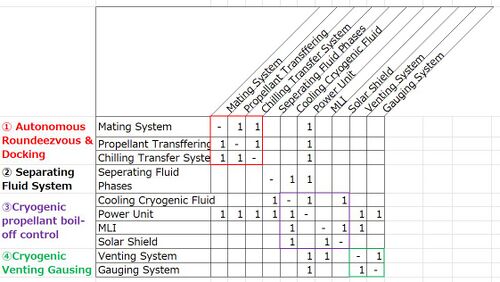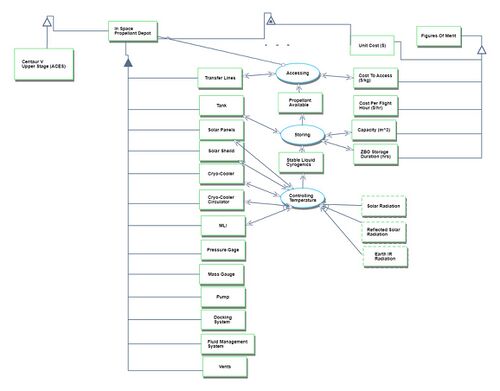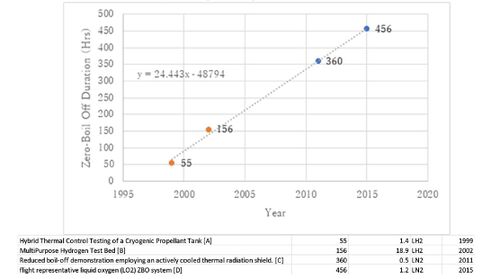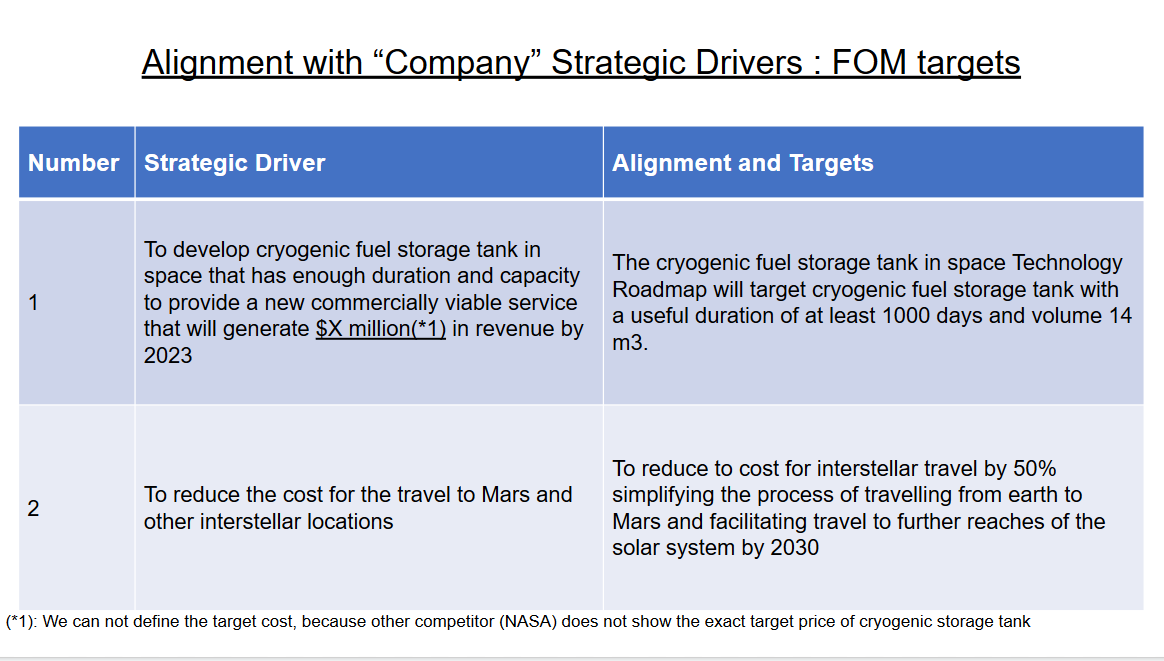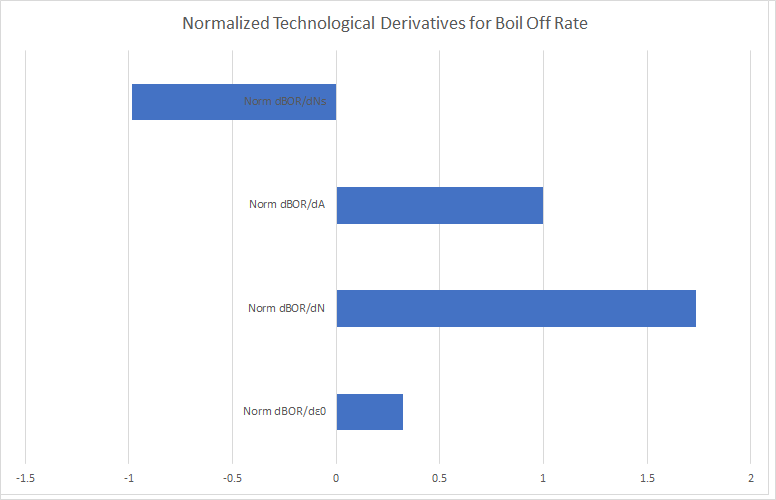Difference between revisions of "In Space Propellant Depot"
| Line 123: | Line 123: | ||
<br> | |||
Multi Layered Insulation is the primary method to prevent radiative heat from entering into the cryogenic storage tank. The emissivity level is the amount of energy which is given off by an energized material. For our system, energy is radiated from the sun (and reflected from the earth). When it contacts our system, we would like to minimize the energy which makes it through to the cryogenic tank. Traditionally Dacron, or some other fiber netting is placed as a spacer between the layers of film to reduce conductive heat between the layers.Miyakita, T. et al showed that by changing to a new form of spacer a much lower emittance can be attained. The new form of spacer, rather than a netting, are hard interlocking spacers that only contact the film in a very small surface area. | |||
The NASA funded project to create a 150W cryocooler capable of 90 kelvin cooling is very important for the implementation of an orbital propellant depot, since it will allow any of the heat which makes it through the MLI to be removed. Previous cryocoolers had a significantly lower cooling capacity and efficiency. The recently funded cooler has shown promise and is a key component in orbital propellant depots going forward. | |||
Storage tanks for cryogens are large pressure vessels which are extremely well insulated against incoming heat. On earth volume less constrained and the main limiting factor is the allowable pressure for a specific pressure vessel design. For objects being sent to space, one of the most critical constraints is the weight. For that reason, even though many cryogenic storage tanks on earth are made out of stainless steel, storage tanks used on space vehicles have traditionally been made out of aluminum due to the lower density. Recent development by NASA and Md.,S.I. et al, has shown that carbon fiber can be an effective storage tank for cryogens. So for the same weight of a tank made out of stainless steel, the volume of a tank made of Aluminum would be larger, and the volume of a tank made of carbon fiber would be even larger. | |||
When looking at the two FOMs of Boil-Off%/day and Volume, a clear difference can be seen. The boil-off rate is significantly higher without the cryocooler project and the new MLI. For the same given mass the volume of a tank using a carbon fiber has significantly larger volume than one using aluminum. | |||
While there hasn’t been a mass limit which was set specifically, the value of having a lighter tank which is able to meet the same volume requirement shows its value when looking at another one of our FOMs,cost to attain. When using the spaceX target of $1000/lb, and the mass of the tank, the cost to launch the tank can be determined. From this it can be seen that the use of the carbon fiber tank saves over 50 million dollars, while also having significantly less boil off per day. | |||
<br> | <br> | ||
Revision as of 01:24, 18 November 2019
Roadmap Overview
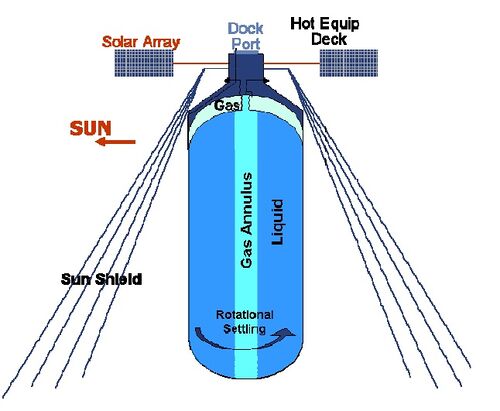 <ref> Kutter,B.F., et al. (2011, September, 9-11) A Practical, Affordable Cryogenic Propellant Depot Based on ULA’s Flight Experience</ref>
<ref> Kutter,B.F., et al. (2011, September, 9-11) A Practical, Affordable Cryogenic Propellant Depot Based on ULA’s Flight Experience</ref>
In the late 1800s James Dewar became famous for his study in the liquefaction of gases such as hydrogen and oxygen. Current Cryogenic storage containers are referred to as dewars. In the 1959 both LOX and LH2 were used to propel the second and third stages of the Saturn rocket. In 1966 LH2 and LOX were chosen to power the Atlas-Centaur rocket. “As early as 1928, scientists studying interplanetary travel began arguing that pre-positioning propellants in orbit would be required for any sustainable large-scale travel beyond Earth.” <ref>Goff Ja et al. “Realistic Near-Term Propellant Depots: Implementation of a Critical Spacefaring Capability” p 2 </ref>. In 2007 Boeing addressed the value of creating propellant depots to increase the payload one could carry to future moon missions <ref> Benioff, D. (2007, October, 1-5) LEO Propellant depot: A commercial opportunity </ref>. This idea was also brought up to Masten space systems in 2008 <ref>Goff, J. et al.(2008) The Case for Orbital Propellant Depots </ref> In 2010 ULA (United Launch Alliance), began to develop ACES (Advanced Cryogenic Evolved Stage) which was a high-performance upper stage rocket with the ability to store and transfer propellant to later missions. ULA also was working on creating CRYOTE (Cryogenic Orbital Testbed) to demonstrate the feasibility of cryogenic fluid management in micro and zero gravity <ref> Gravlee, M., et al. (2011) Cryogenic Orbital Testbed (CRYOTE) Development Status </ref>. In 2018 Vice President Pence at the 34th Space Symposium outlined the plan to have NASA return to the moon with the eventual use of a space depot. <ref> Pence, M.R. (2018, April, 16) Remarks by Vice President Pence at the 34th Space Symposium | Colorado Springs, CO </ref>. To date though there has been no space tested propellant depot.
Design Structure Matrix
Object Process Diagram
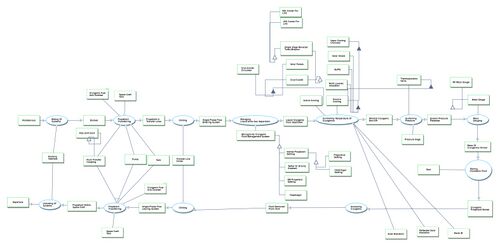
The above diagram shows the objects and processes required for an in-space propellant depot
In-Space Propellant Depot Technology Roadmap
2ISPD -In-space Propellant Depot
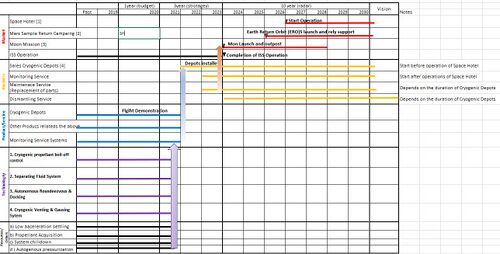
The above technology roadmap shows the roadmap to an in-space propellant depot based on the dates provided by the ULA for the centaur V rocket which should contain a type of in space propellant depot
In-Space Propellant Depot Roadmap OPM
Figures of Merit
The FOMs are following:
● Duration of ZBO storage [days]
● Maximum Capacity [m^3]
● Unit Cost [$]
● Cost per hour(operational and maintenance [$/hr]
● Cost to attain per weight [$/kg]
The above graph shows data for the developed testbeds which did in fact reach Zero Boil-Off (Duration vs. Year). Albeit these are for different gases, the first two are LH2 and the second two are LN2 (simulating LOX). LH2 has to be stored below 20K and LOX needs to be stored below 90K. The methodology used for storage is the same (aside from the necessary temperature), so the progress in duration of sustained zero-boil-off is still relevant since the improvements for one could be used for the other. The dFOM/dt found is 24.4 hours ZBO/year.
For this specific FOM the theoretical limit is likely close to inifite, but once long term ZBO is attained there would be other figures of merit which would have limits. For example, the power necessary to sustain ZBO would have a limit based on the amount of power which could be generated by the solar panels and the structure to support them. Similarly, the capacity of the tanks would have limits based on the structural limitations and the force of gravity of the depot.
Were the testing on each of these done for longer duration there would be significant boil-off <ref> Chai,P.R., et al. (2013, December, 16) Cryogenic thermal system analysis for orbital propellant depot</ref>. A better predictive metric would be the % boil-off per month, but none of these tests were performed for a month or more. The current state of the FOM is slowly increasing but is limited by the cooling capacity of the cryocoolers currently available. Were the Fuel used to be liquid methane instead of LH2, the completion of the development of a 150W 90K cryocooler by Creare (being funded by NASA) <ref> Platcha, D. (2017, July, 7) NASA cryocooler technology developments and goals to achieve zero boil-off and to liquefy cryogenic propellants for space exploration </ref> would allow ZBO for a propellant depot containing LOX [7]. Methane has a higher boiling point, so it would likely be able to sustain ZBO as well. Both SpaceX and Blue Origin plan on using Methane/LOX powered rockets, so this may well be a useful and attainable technology in the near future.
Alignment with "Company" Strategic Drivers: FOM Targets
Positioning of Company vs. Competition : FOM charts
In order to better understand the current state of cryogenic storage a comparison was made between our theoretical system and some other systems. It seems fair to compare our system to at least one other theoretical space based system. For this we used the NASA system described in the road map. To determine the boil off, we used the first paper discussed in question 2 which calculated the boil off for a theoretical system using modern day cryocoolers. Since NASA would be using LH2 as a cryogen, and the cooling capacity wouldn’t have increased much from what was described in the paper (10W to 20W; 120W needed for ZBO), I believe that this is a fair estimate. The other two systems which were chosen were different sized LO2 storage tanks which are earth based. While the architecture of both is different the working principle is the same. Only the theoretical cost for the NASA system was readily available, in order to acquire the cost for the other two a quote would need to be requested.
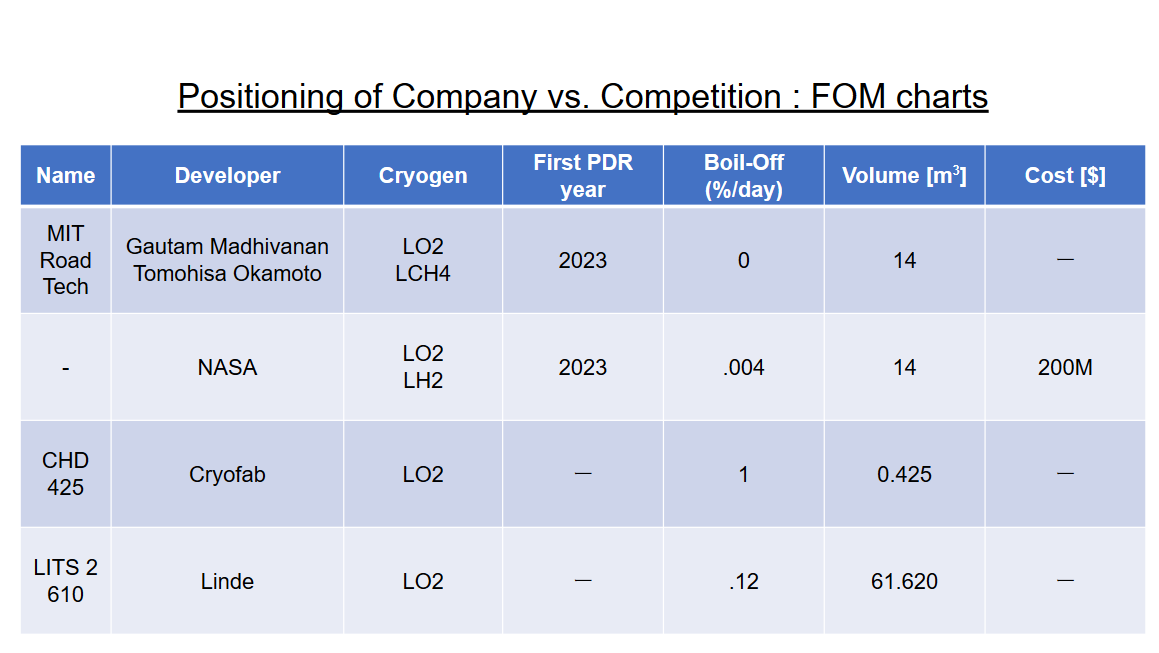
Technical Mode: Morphological Matrix and Tradespace
One of the most important FOM for this system is the duration which it can sustain a cryogen. This is determined by how long the system can keep the boil off rate at zero. Patel, C. N. et al “Design of Low Heat Leak Liquid Helium Dewar” 2016 showed a simple method to model the performance of a dewar (cryogen storage container) along with actual values corresponding to the variables, which was challenging to find for commercially developed cryogenic storage tanks. Even though this paper is creating a helium dewar, the relationship between the variables is relevant for different cryogens. Since the cryogenic tank was insulated using MLI (multi layered insulation) the equation developed by lockheed martin to model the performance of MLI was used to model the heat leak through the body of the tank.

While most values were defined in the paper, some values (he (latent heat of vaporization) and ρ (density)) had to be acquired from outside sources (https://encyclopedia.airliquide.com/helium).
Cs 8.95E-08
Cr 5.39E-10
TH 300 K
Tc 4.5 K
Tm 152.25 K
N 20 layers/cm
NS 40 radiation shields
ε0 0.02
A 5.6194 m^2
he 20754 J/kg
D 1.06 m
L 1.06 m
V 1.126455762 m^3
ρ 125 kg/m^3
mtotal 140.807 kg
The boil off rate can be determined by multiplying the heat leak by the inner surface area of the container and the conversion faction 86400 (60s/min*60min/hr*24hrday) then dividing by the latent heat of vaporization and the total mass. Then multiplying by 100 gives the boil off rate. The resulting equation is

The variables which could be varied by design without changing the cryogen, are the area (A), MLI density (N), emissivity (ε0), and number of radiation shields (Ns).




Once the values were entered and the derivatives were normalized the values were plotted in the tornado chart below. From this it can be seen that increasing the density of the MLI (layers/cm) has the strongest effect per percentage on the boil off rate. Also while Volume (another one of our figures of merit) is not specifically defined in this equation, the area (A) is. It can be seen that increasing the area increases the BOR. Since the area is directly related to the volume (where area is dV/dr) it can be seen that the FOM of volume is in tension with the FOM of BOR.
This model could be improved by adding heat leak from different sources as well as adding in the negative heat leak from adding in a cryocooler. The equations to model these other sources could be determined from Platcha, D. M. “Passive ZBO storage of liquid hydrogen and liquid oxygen applied to space science mission concepts” 18 November 2005.
Based on data available from NASA and from suppliers of earth based cryogen storage we were able to create a morphological matrix detailing some of the subsystems used on cryogenic storage devices. Based on the cryogen which is being stored, different equipment may be necessary. For example if a cryocooler was being used, LH2 would need one which operates at a colder temperature.
Anytime that a cryocooler is used, power would be necessary. For both of the earth based systems which were found, cryocoolers were not used, so power was not needed.
For systems in space, predicting the location of the liquid vs the gas can be complicated, to simplify this certain settling methods are used, while on earth based systems this isn’t necessary since the denser liquid settles to the bottom of the tank via gravity.
Insulation is one of the more divisive topics within the matrix since each of the items can be further deconstructed. It does seem that earth based systems typically don’t use MLI or sun shield, while space based generally do.

Keys Publications and Patents
Chai P. R. et al “Cryogenic thermal system analysis for orbital propellant depot” 16 December 2013
The importance of this paper mainly lies in figure 14 and 15 on page 44 and table 5 on page 45. These figures show for LOX and LH2 the amount of boil off for different designs for different total mission durations. From these, the benefits of active cooling can be seen for storing cryogens. It also shows that there would be a significant benefit to achieving zero-boil off for the cryogen. Table 5 shows what the current cooling capacity is for state of the art cryocoolers, and what would be necessary to achieve zero boil off. While the cooling capacity in order to achieve zero boil off for oxygen is not too far from what the current state of the art is capable of (at the time of this paper), the cooling capacity for hydrogen ZBO is more than an order of magnitude greater than what we are currently capable of.
Platcha, D. et al “NASA cryocooler technology developments and goals to achieve zero boiloff and to liquefy cryogenic propellants for space exploration” 7 July 2017
This paper is one of the most recent papers available on the topic of in-space cryogenic storage depots. It covers the current status of cryocoolers and details the plans by NASA to develop two new cryocoolers. One of the cryocoolers is intended to move us closer to being able to store hydrogen with ZBO, while the other is for storing LOX. The cooler for LOX, per the previously mentioned paper would have the necessary cooling capacity to store LOX with zero boil-off. This paper also covers the different circulators available for circulating the cryocooler fluid over a large area to cool the entire cryogen tank.
US Patent 9488313 B2
This patent posits the use of aerogel, as opposed to vacuum to insulate the contents of a cryogenic storage tank. There are several good reasons for taking this approach. A vacuum needs to be maintained to have consistent insulation. Also vacuum requires both an inner and an outer shell. Two separate shells add weight to the system. Also the manufacture of vacuum storage can be difficult. The aerogel based insulation does not require repeated vacuuming. It can save up to 10kg in a 40 foot cryogen storage container and is not as difficult to manufacture. There is also the added benefit that the aerogel can contain fire preventive material. The benefits of Aerogel options are compared to MLI in Fesmire J.E. “Aerogel-Based Insulation Materials for Cryogenic Applications” 2018. The most valuable FOM for this subsystem is the thermal conductivity, which we are trying to minimize. Per the aforementioned paper, a combination of MLI and Aerogel is one of the more attractive options. This possible reduction in weight without significant increase in thermal conductivity may allow a comparably larger volume cryogenic storage tank.
Goff, Jonathan & Kutter, Bernard & Zegler, Frank & Marchetta, Jeffrey. (2009). Realistic Near-Term Propellant Depots: Implementation of a Critical Spacefaring Capability. 10.2514/6.2009-6756.
This paper details some of the options available for various critical subcomponents and the pros and cons of each. For example one of the important subsystems is that of the propellant settling, which keeps the separation between the liquid and gas phases to prevent multiphase flow into the docked spacecraft. The article shows what the current options are and even gives the TRL level for a few. It also details some of the different ways these subsystems have been integrated into theoretical and experimental systems. This article provides specific value for developing a morphological matrix for this technology.
List of R&T Projects and Prototypes
Multi Layered Insulation is the primary method to prevent radiative heat from entering into the cryogenic storage tank. The emissivity level is the amount of energy which is given off by an energized material. For our system, energy is radiated from the sun (and reflected from the earth). When it contacts our system, we would like to minimize the energy which makes it through to the cryogenic tank. Traditionally Dacron, or some other fiber netting is placed as a spacer between the layers of film to reduce conductive heat between the layers.Miyakita, T. et al showed that by changing to a new form of spacer a much lower emittance can be attained. The new form of spacer, rather than a netting, are hard interlocking spacers that only contact the film in a very small surface area.
The NASA funded project to create a 150W cryocooler capable of 90 kelvin cooling is very important for the implementation of an orbital propellant depot, since it will allow any of the heat which makes it through the MLI to be removed. Previous cryocoolers had a significantly lower cooling capacity and efficiency. The recently funded cooler has shown promise and is a key component in orbital propellant depots going forward.
Storage tanks for cryogens are large pressure vessels which are extremely well insulated against incoming heat. On earth volume less constrained and the main limiting factor is the allowable pressure for a specific pressure vessel design. For objects being sent to space, one of the most critical constraints is the weight. For that reason, even though many cryogenic storage tanks on earth are made out of stainless steel, storage tanks used on space vehicles have traditionally been made out of aluminum due to the lower density. Recent development by NASA and Md.,S.I. et al, has shown that carbon fiber can be an effective storage tank for cryogens. So for the same weight of a tank made out of stainless steel, the volume of a tank made of Aluminum would be larger, and the volume of a tank made of carbon fiber would be even larger.
When looking at the two FOMs of Boil-Off%/day and Volume, a clear difference can be seen. The boil-off rate is significantly higher without the cryocooler project and the new MLI. For the same given mass the volume of a tank using a carbon fiber has significantly larger volume than one using aluminum.
While there hasn’t been a mass limit which was set specifically, the value of having a lighter tank which is able to meet the same volume requirement shows its value when looking at another one of our FOMs,cost to attain. When using the spaceX target of $1000/lb, and the mass of the tank, the cost to launch the tank can be determined. From this it can be seen that the use of the carbon fiber tank saves over 50 million dollars, while also having significantly less boil off per day.
